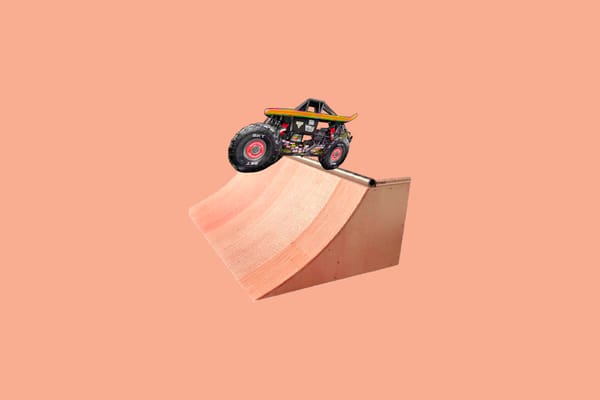The flashy and painful parts
Plus: A pigeon on yer head and heart, grease 'em up, listen to hell, and more.

The definitive weekly ranking and analysis of all the skateboarding and other online things that I cannot stop consuming and how they make me feel, personally.

The flashy and painful parts
Rank: 1
Mood: 📚
One thing that is certain is the uncertainty of our shared history, especially in the online age. Like a scar or a gaudy gold ring, the past only exists if we carry it with us and show it to everyone we can. There have always been those who’d rather not, instead, misconstruing, lying about, and banning what it is that made us who we are. However, now that so much of our history lives on and through the internet, something as simple as forgetting to pay a domain hosting bill, a sneaky piece of malware, or a company’s desire to save on server space can easily erase decades’ worth of archives.
Earlier this year, the once ubiquitous image-hosting site Imgur removed an unspecified number of “explicit images” and “old, unused, and inactive content,” which, as Ars Technica noted at the time, “It’s nobody’s obligation to host images indefinitely for free, but Imgur has been around long enough that such a culling will likely result in untold amounts of link rot—web pages missing vital pieces of context.” And just last week, a glitch at Twitter (Now “X”) deleted most pictures and links posted before December 2014.
While we like to think that the internet is forever, it simply is not. When it comes to skateboarding media, what happens if Thrasher’s YouTube page ever gets accidentally deleted or removed due to some policy violation? The Library of Alexandria of modern skate videos is gone. If Instagram ever self-immolates like Twitter, a generation’s understanding of skateboarding and its vehicle of discovery will vanish.
That’s why I don’t think it’s hyperbole to say that Kevin Marks’s work with Look Back Library is an essential step in preserving skateboarding history. What started as a project to improve a local skate magazine library has since grown into a network of nearly 180 Look Back Libraries around the world. Print magazines, while now niche in the wake of the internet’s takeover, are still the record of skateboarding culture itself.
Sure, much of what was in their pages during the golden era of print was more or less dictated by industry trends, as skate mags were initially designed as marketing opportunities for brands, but that doesn’t mean they don’t carry significant historical importance. Plus, that dynamic has been changing in recent years with the rise of smaller independent magazines whose mandates aren’t solely driven by appeasing advertisers.
Keeping our connection to print in the way Marks does is invaluable and gives us a direct link to the glossy pages of skateboarding history. It’s also a significant amount of work, as Marks is constantly travelling, collecting magazines, and establishing and fleshing out more and more skate magazine libraries. It’s a worthy effort that keeps the past — including the flashy and painful parts — alive and in the present.

Watch out! It’s a strained analogy.
Rank: 1
Mood: 🐦
This, I think, is what falling in love with skateboarding is like. You become smitten, take it everywhere, it constantly shits all over you, yet you make it integral to your entire being. That’s beautiful, really.

Grease ’em up
Rank: 3?
Mood: 🛢
A cold yet accurate definition of a professional skateboarder is that they’re sentient marketing real estate. Of course, they are also supremely talented athletes, definers of culture, and human beings with complex inner lives that include hopes, dreams, and, on occasion, crushing student debt. But it’s precisely those things that make their personalities and accompanying quirks such enviable territory for brands to slap a logo on.
Those skills and attendant humanness are what appeal to the purchasing public at large, which is what brands that sell products are looking for when choosing a skateboarder to give their money or product to. This is why it’s somewhat surprising that the contemporary PRO seems less concerned with carving out a persona or “look” for themselves in an industry that rewards those who make drafting a marketing pitch easy, especially in an age where the level of talent is so high that it’s only becoming harder to stand out with ability alone. While fashion homogenization has always been a part of skateboarding — neon short-shorts, Dickies, baggy pants, skinny jeans, Dickies again, Big Boys, Dickies one more time — it’s the outliers, weirdos, or those that put a signature twist on the look du jour that come to shape how we remember a generation.
However, the risk in attempting that is clear: portraying yourself in what others perceive as an inauthentic way will have the opposite intended effect — decades on, people still bag on Chris Cole for tightening up his wardrobe once he enlisted in the Zero Army. That’s because we live in a culture obsessed with image and authenticity, and skateboarding is an industry fueled by both, making creating an authentic image a delicate and dangerous proposition. A freak (positive) like Ben Kadow feels genuine, is fun to watch and captures the imagination. Burberry Erry feels sad, soulless, and calculated like the runoff pooling at the bottom of Instagram’s “For You” algorithm. So what should the PRO of today do? Try out the Full Greco gamut? Adopt a zany Lizard King-esque persona? Stick to their Big Boys?
This isn’t to say the modern PRO is inherently indistinct or lacks character. Far from it. Some of the names with the most heat in skateboarding right now are those like Akwasí Owusu, Chandler Burton, John Shanahan, and Lavendar Nora — skateboarders with easily identifiable and marketable “looks” and personalities. That’s not the only thing that makes them exciting — they’re all excellent on a board to boot — but it helps them stick in the mind and connect with fans in a landscape littered with amazing talent. It also likely helps them accrue and maintain sponsors, which is the cold yet accurate definition of how a professional skateboarder sustains themselves.
Having a thing that makes a person stand out as a skateboarder might even lead them to money-making opportunities outside of the traditional skateboarding industry, like how the criminally underrated Brandon Burleigh transformed himself into Steve from The Outsiders and recently got himself a hair grease sponsor.
Which is what it’s all about, right? Endorsements. Notoriety. Brand alignment — we all strive for it in our own way. All you have to do is dip those fingers into the proverbial pomade and smear it across your being.

The Bible sins?
Rank: 2
Mood: 🏠
If you’ve ever spent an inordinate amount of time just hanging around a skate shop, then you know the critical role they play in creating and fostering community. Thrasher’s “Established: KCDC” does a great job of detailing the importance of that and all of the effort shopkeepers like Amy Ellington make to keep scenes alive and open them up to new generations of skateboarders.
Beyond that, however, my main takeaway from watching the video was that it’s a Thrasher piece produced by Red Bull Media House. Curious! When did this creative partnership take place? Why is it happening? Have they done anything like this before? Does it portend more monied companies creating content for The Bible? Does it matter who creates said content as long as it’s good? I guess we’ll find out.

Listen to Hell
Rank: 1
Mood: 😈 🎼
Joseph Shabason, a talented musician and all-around nice guy, has gone and made something special. With the blessing of Ed Templeton himself, he’s taken Toy Machine’s Welcome To Hell and rescored it. The resulting effort also serves as Shabason’s latest album, aptly titled Welcome To Hell, released by Western Vinyl and Telephone Explosion Records. You can pre-order it now from his Bandcamp.
Full disclosure: I was asked to write the press release for Shabason’s Hell. As preparation, I watched the original and the rescored version back-to-back several times. What stood out to me then, and what I still think of now, is the personal intricacies of each of Shabason’s songs. The soundtrack in each section of the original video is reinterpreted in a way that one would like to think reflects Shabson’s long-held understanding of its structure and cast of characters initially absorbed through countless viewings of Hell in his youth but with the added context, emotion, and creativity of his present.
It’s, in essence, what we all do when watching a skate video — we create our own vision of the skateboarders on screen and how they move about the world as people as much as they do on their skateboards. These simulacra exist solely in our minds. In Shabason’s case, however, he’s made a beautiful record of them. All of that to say, you’ll find the press release in full below. Also, just look at the thing. Damn.

What does hell look like? The introduction of Toy Machine skateboard's seminal 1996 video “Welcome To Hell,” with its pulsing overlay of the Stars and Stripes on top footage of police officers, businessmen, and fast food service workers, would appear to paint hell as the mirage of American exceptionalism. A thick, centuries-spanning unreality that may not outwardly trade in fire and brimstone, but if you turn your nose to the wind, you’ll smell sulphur.
What comes after that scene, born of — or despite — those apparent depictions of damnation, would become a cultural touchstone: skateboarding performed at the highest level, composed and displayed in a fashion that would influence and endear audiences for decades to come. “Welcome To Hell” features a unique and progressive patchwork of skateboarders, most of which would become icons in their world, and helped redefine what the modern skateboarding video could be.
A young Joseph Shabason felt that impact. The acclaimed musician hit rewind on his VHS copy of “Welcome To Hell” hundreds of times in his youth, each watch as thrilling as the last. That invigorating, improvisational, full-body experience of skateboarding is one that Shabason likens to jazz, where a shared language exists between the wheels and woodwinds. The way the skateboarder and musician command that language is what distinguishes them, adding definition to the mercurial concept of “style.” This connection becomes most apparent in collaboration; ensembles of skaters and musicians are a noisy, creative bunch. Reflecting on this relationship and the Toy Machine classic would ultimately lead Shabason to wonder: what does hell sound like?
The answer was a concept album that, like his previous records, lives in the personal. One that, much like skateboarding itself, would push him to try something new: rescoring “Welcome To Hell.” The video’s original soundtrack served as a musical awakening for many — an active, aggressive mix of songs from bands like The Misfits, Black Sabbath, and Sonic Youth. Here, you’ll find that recontextualized, softened, yet no less energizing. Over the album’s ten songs, Shabason plays with the angular and ambient, exploring large group melodies that move forward with the on-screen action, shifting the mood in subtle and substantial ways that reframe our understanding of this culture-defining skate video and the skateboarders in it.
In Shabason’s “Hell,” quintessential “East Coast powerhouse,” Mike Maldonado is backed by a sharp, driving modal composition that calls back to 1970s Miles Davis, the melodic sensibilities of Azimuth, and stands as a fascinating complement to Maldonado’s hard-charging on-board approach. The debut of Elissa Steamer, a pioneer decades ahead of her time, is given fresh spirit with an off-kilter funk. Brian Anderson, whose virtuosic section was originally guided by a dour Pink Floyd track, now flies across the screen in jazzy fits and starts, punctuated by the joyous wail of Shabason’s saxophone. Nowhere does the fluid and improvisational intersection of skateboarding and jazz meet and swell than with Donny Barley. His easy, instinctual cool flecked with tinkling synths and bass lines that echo the natural power of Barley’s abilities.
Shabason then creates what could be rightly considered an audio portrait of Ed Templeton. The celebrated visual artist, photographer, and founder of Toy Machine cuts a distinct profile, which Shabason distills with a throbbing, slanted rhythm and an eerie layering of feedback and pressuring keys. The “curtains” section in “Welcome To Hell” belongs to Jamie Thomas, whose career-defining performance here would set the stage for a decades-spanning career and a level of influence in skateboarding that is still felt today. Shabason meets Thomas’ epic with a commanding, angular rhythm that builds and flows with the momentum of his skateboarding. Airy group melodies mingle with a wonked-out vibraphone and tight percussion that lets loose in florid bursts before devolving into a finishing sequence of muscular improvisation — a fittingly bold interpretation of the work of one of skateboarding’s most daring practitioners.
Finally, as if ending with his thesis statement, the last song of Shabason’s “Welcome To Hell” is a calming vocal harmony that lies atop the video’s infamous “bail section.” A horrific collection of skateboarders falling and twisting themselves into agonizing, unnatural shapes — a Hieronymous Bosch captured on VHS. It’s the culmination of the unexpected made whole. Shabason’s album a provocative reimagining that instills a new sense of awe in the 27-year-old classic, prompting the question first posed by the original: what if hell was a place you wanted to return to again and again?

Something to consider:

A good thing about a good thing: José Vadi on Slow Impact for Alta Journal.
A good thing about a bad thing: Not that you needed all these words to tell you what is already clear, but Ronan Farrow does a good job at laying out how widespread government incompetence and privatization have led to rich dipshits like Musk amassing so much power and influence. Fun. “Elon Musk’s Shadow Rule” via the New Yorker.

A funny thing about a bad thing: I am going to stop writing so much about Street League and their deal with Rumble because it’s mostly a bummer, and there’s not much else to say at this point other than “yuck,” but I thought this data gathered by Media Matters was interesting. Despite having an exclusive streaming partnership with the right-wing video-hosting platform, Street League still cannot make it onto Rumble’s “leaderboard” of most popular programming. In fact, all of Rumble’s sports content gets dusted by QAnon influencers, Manosphere dorks, and the indomitable slice of the pie chart known as “other.” lol.

Until next week… pay a visit to your favourite local bookshop. Walk through the aisles. Take in the smell of books old and new. Trace your finger across their spines as you pass. Wait — did something catch your eye? Pull it from the shelf and read the synopsis. Seem interesting? The cover sure is beautiful. Why not take a chance? C’mon. You scared? What the hell, man, just try it. What do you have to lose? You’ve got nothing else going on today. Get the damn book and bring it to a park bench. Okay, great. You won’t regret this. Yeah, it’s one of those weird ones where you can’t really tell — no, you have to tap your card on the back of the machine.


I wrote a book about the history and cultural impact of Tony Hawk’s Pro Skater, and I will keep posting about it at the end of the newsletter for the foreseeable future. Apologies. It’ll be in stores on September 26 and you can pre-order Right, Down + Circle now from your favourite local bookshop, my publisher ECW Press, or all of the usual devils (Amazon, Barnes & Noble). I think you might like it.





